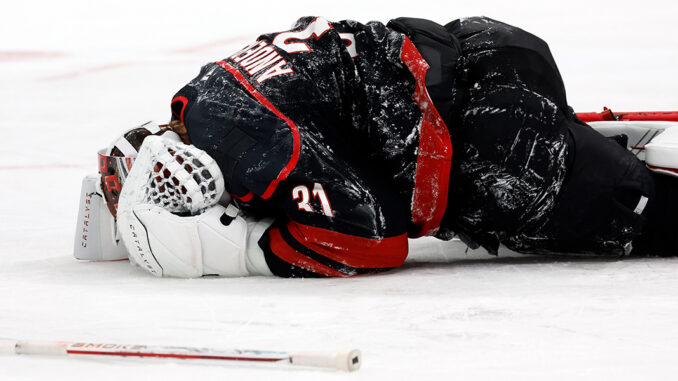
Hurricanes goaltender Frederik Andersen lays on the ice after a collision with teammate Jordan Staal during the third period of Carolina’s 4-1 loss to the Capitals on Nov. 11 at Lenovo Center. (Karl DeBlaker / AP Photo)
RALEIGH — The NHL, like most professional sports leagues, has toed a delicate line with concussions, realizing that a flat-out denial of the impact of head injuries in hockey is no longer a reasonable defense.
Still, the league, which has faced criticism after several past enforcers’ deaths were tied to the repercussions of fighting and blows to the head, is often secretive about how it handles concussions.
One sign of progress is the league’s use of concussion spotters, who have the authority to pull a player from the game if they are determined to have exhibited signs of a head injury.
Such was the case last Tuesday when Hurricanes goalie Frederik Andersen was pulled from the game against the Capitals with just over five minutes remaining in the game following a collision with teammate Jordan Staal.
Andersen was slow to get up from the ice, though he said it was because he felt a twinge in his back after being “twisted the wrong way” after colliding with the rare player who is as big as his own 6-foot-4, 229-pound frame.
“It was just more about the other part of my body, not even the concussion part,” Andersen said. “I just got up quick. I knew Doug (Bennett, the Hurricanes’ head trainer) was right there. I just kind of wanted to skate away and get over and do my thing, get some water like I usually do in the TV timeout.”
But as Andersen stretched in his crease preparing to continue play with Carolina trailing 3-1, one of the linesmen came over to tell Andersen he had been flagged by the league’s concussion spotter.
“I was very surprised because, if anything, I think the one collision in the first would be the one that should have warranted some sort of a review or something,” Andersen said of Capitals forward Nic Dowd colliding with him earlier in the game. “He made contact with the head there.”
After exiting the ice surface, Andersen was taken to the team’s training room in the Lenovo Center, a place where he can take the necessary tests without the full noise and distractions of the arena.
“The test can be tough if you’re out there, like with all the different sounds and stuff,” he said. “So I’m sure you’ve got to focus up a little bit to kind of get close to your baseline.”
The baseline is cognitive tests players take before the season that give doctors and trainers a benchmark to compare the player’s test results after the event that led to them being pulled from the game.
“It’s an iPad test,” Andersen said. “There’s a few different ones. … memory stuff or balance stuff, recalling numbers and random stuff, words you’ve got to remember. So if you’re not fully there, it could definitely show as a sign that you’re not fully with it.”
For Andersen to do the balance tests, he needs to take off his skates — a bit more of a process for a goalie than a forward or a defenseman. Andersen said the tests are five to 10 minutes, which, on top of the time it takes to take off and put on equipment, can keep a goalie out of the game for a decent chunk of time.
He said by the time the Hurricanes returned to the locker room following their 4-1 loss, he was done with his test and in the locker room with the team.
Andersen said he has in the past recognized when something was not right following a collision, like when New Jersey’s Timo Meier made contact with him in Game 4 of last year’s first round playoff series, knocking him from the game.
“At the end of the day, they’re trying to protect us and themselves,” he said. “They’re trying to protect both parties.”
He also admitted that it’s easy for an athlete’s competitive nature to lead them to overlook or ignore warning signs.
“I think when you’re in the moment,” he said, “you want to keep competing and being out there. … You may ignore some signs that made you feel, maybe, that you’re not right there, but they take you out in a little bit quieter room, in the training room or something, where you can just go through it.”
In Andersen’s recent situation, he knew he wasn’t going to be a key part in Carolina trying to erase a two-goal deficit in the final minutes of a game, making the concussion spotter’s decision a bit easier to swallow.
He also said it helps that it’s the team’s trainers and doctors, people who know the players and their usual demeanor, evaluating the results and are better suited to “see if something’s up.”
“At the end of the day,” Andersen said, “you’re thankful that you have people that try to look out for you.”

